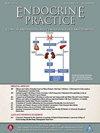cgm引导下危重患者胰岛素输注可提高安全性、时间效率和提供者满意度。
IF 4.6
3区 医学
Q2 ENDOCRINOLOGY & METABOLISM
引用次数: 0
摘要
目的:评估实时连续血糖监测(rtCGM)与胰岛素输注计算机计算器(IICC)的集成,以改善重症监护病房(ICU)的血糖控制、时间效率、安全性和临床医生工作流程。方法:回顾性分析35例外科和内科重症监护病房需要胰岛素输注的危重成人患者。Dexcom G7 rtCGM值被整合到机构开发的IICC中,使用正在进行的验证协议,允许非辅助CGM使用。rtCGM的准确性通过使用平均绝对相对差(MARD)、监测误差网格和Parkes误差网格分析比较匹配的CGM和POC葡萄糖值来评估。CGM时间范围(TIR)指标、临床医生血糖监测周转时间(TAT)和护士满意度也进行了评估。结果:共分析了1291对匹配的葡萄糖对。rtCGM系统的MARD为12.5%,99.6%的值落在Parkes误差网格上的临床可接受的误差区域(a +B)内。rtCGM-IICC方案的患者平均血糖141.9 mg/dL,平均TIR (70-180 mg/dL) 82.8%,高于范围(bb0 -180 mg/dL) 14.5%,低于范围(结论:在ICU中将rtCGM与IICC方案结合可以增强血糖控制,提高工作效率,减少临床医生工作量,同时保持较高的准确性。本文章由计算机程序翻译,如有差异,请以英文原文为准。
Continuous Glucose Monitoring–Guided Insulin Infusion in Critically Ill Patients Promotes Safety, Improves Time Efficiency, and Enhances Provider Satisfaction
Objective
Evaluate the integration of real-time CGM (rtCGM) into an insulin infusion computer calculator (IICC) to improve glycemic control, time efficiency, safety, and clinician workflow in the intensive care unit (ICU).
Methods
A retrospective analysis was conducted on 35 critically ill adult patients requiring insulin infusion in the surgical and medical ICUs. Dexcom G7 rtCGM values were integrated into an institution-developed IICC using an ongoing validation protocol, allowing for nonadjunctive CGM use. The accuracy of rtCGM was assessed by comparing matched CGM and point-of-care (POC) glucose values using mean absolute relative difference (MARD), surveillance error grid, and Parkes Error Grid analyses. CGM time-in-range metrics, clinician turnaround time for glucose monitoring, and nurse satisfaction were also evaluated.
Results
A total of 1291 matched glucose pairs were analyzed. The rtCGM system demonstrated a MARD of 12.5%, with 99.6% of the values falling within clinically acceptable error zones (A+B) on the Parkes Error Grid. Patients in the rtCGM-IICC protocol had mean glucose 141.9 mg/dL, with mean time in range (70-180 mg/dL) 82.8%, time above range (> 180 mg/dL) 14.5%, and time below range (< 70 mg/dL) 0.5%. Clinician time efficiency improved significantly, with POC testing requiring a mean turnaround time of nearly 5 minutes compared to 3-second CGM retrieval. All surveyed nurses (n = 20) reported rtCGM increased efficiency and improved safety and preferred rtCGM with POC over POC testing alone.
Conclusion
Integrating rtCGM with an IICC protocol in the ICU enhances glycemic control, improves workflow efficiency, and reduces clinician workload while maintaining high accuracy.
求助全文
通过发布文献求助,成功后即可免费获取论文全文。
去求助
来源期刊

Endocrine Practice
ENDOCRINOLOGY & METABOLISM-
CiteScore
7.60
自引率
2.40%
发文量
546
审稿时长
41 days
期刊介绍:
Endocrine Practice (ISSN: 1530-891X), a peer-reviewed journal published twelve times a year, is the official journal of the American Association of Clinical Endocrinologists (AACE). The primary mission of Endocrine Practice is to enhance the health care of patients with endocrine diseases through continuing education of practicing endocrinologists.
 求助内容:
求助内容: 应助结果提醒方式:
应助结果提醒方式:


